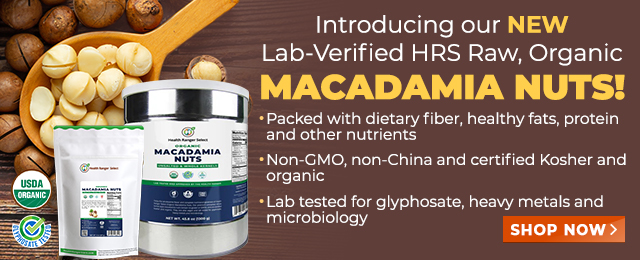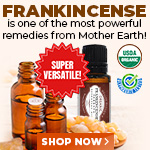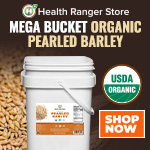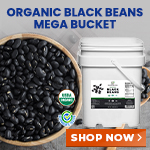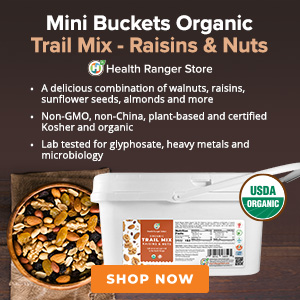Make your own antibacterial bandages with these garden plants
Tuesday, January 13, 2015 by: Jennifer Lilley
Tags: gardening, antibacterial bandages, herbal medicine
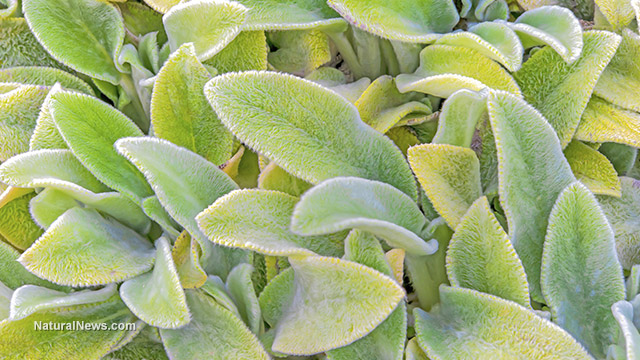
- Newly released JFK files reveal Pentagon's role in creating Lyme disease and covid in the same lab
- CDC finally halts $11 billion COVID funding scam as health officials admit the ‘pandemic’ was a fraud
- DEADLY DECEPTION: How COVID vaccines increased mortality rates and why authorities hid the truth
- Here are TEN all-natural ways to protect your garden without using harmful chemicals
- GAIN-OF-FUNCTION CAT-BIRD-FLU now on the rise as nearly a dozen cats in Colorado "test positive" for Bird Flu due to contaminated cat food
- Ginseng's hidden anti-aging power: How compound K is rewriting the rules of skincare
- “Endgame: The Hidden Agenda 21” unveils a world of conspiracy and control
- Senate Democrats deny censorship industrial complex existed, defend government's role in silencing dissent
- ATTENTION PRESIDENT TRUMP: Please WITHDRAW your nomination of Dr. Susan Monarez for CDC Director as she is a VAX FANATIC and TOXIC JAB ZEALOT
- Scientists demand FDA withdraw mRNA COVID vaccines amid contamination and gene therapy concerns
- L.A.'s rebuilding nightmare: Only 4 permits issued after fire destroys 6,000 homes
- “The shame of Minnesota”: Somali immigrants behind $250 million child nutrition fraud in largest COVID-era scam
- Former Congresswoman exposes CCP's deep infiltration of California through universities, ports, and fentanyl
- Despite surge in MMR vaccination in Texas, measles outbreaks continue: Is VACCINE SHEDDING fueling the spread?
- PROCESSED TABLE SALT in foods found to fuel depression
- Chewing gum's dirty secret: How your daily habit could be flooding your body with microplastics
- BPA: The hidden hormone disruptor sabotaging your health - and how to fight back
- Judicial bias exposed: Judge who blocked Trump's gang deportations attended secretive left-wing conference
- Newly released JFK files reveal Pentagon's role in creating Lyme disease and covid in the same lab
- Analysis: The coming economic collapse, a mass uprising and Trump's three secret weapons to halt the growing revolt
- Festive flavors: The sweet history, nutritional profile and health benefits of pecan pie
- Elon Musk: Aliens could be here on Earth RIGHT NOW
- Trump reverses course on Gaza plan, says “nobody is expelling Palestinians”
- Big Pharma's $8 Billion bribery scheme exposed: how doctors are pushed to prescribe junk science, not heal
- Boys are back in town: Trump’s patriotic alpha crew takes the wheel while toxic females ride in the backseat
- Reclaim your health: How midlife exercise reverses years of inactivity
- A lack of integrity in Academia: Harvard professor found GUILTY of fraudulent research to promote CRT theory
- Survival 101: Effective EMF blocking techniques
- EPA advisor admits the agency is funneling billions to climate groups ahead of Trump’s return to White House
- Dr. Mike Yeadon releases 15-minute testimony - WATCH - about genocidal intent of COVID “vaccines”
- 5 Simple steps to boost your brainpower: How to strengthen executive function in a distracted world
- Florida takes a stand: DeSantis proposes permanent ban on mRNA vaccine mandates
- Sugarcane extract superior to cholesterol-lowering drugs?
- Mike Adams Sermon 66: God will DESTROY ISRAEL for its wickedness
- Pilots report mysterious lights 'moving at extreme speeds' across Oregon skies
- Space war brewing? Russia threatens to destroy Starlink satellites
- EPA advisor admits the agency is funneling billions to climate groups ahead of Trump’s return to White House
- California's social media censorship law struck down: A victory for free speech or a threat to online safety?
- The Health Ranger releases “Vaccine Zombie” song and music video, using AI-animated zombies for the music video
- Dr. Mike Yeadon releases 15-minute testimony - WATCH - about genocidal intent of COVID “vaccines”
- The pandemic as a tool for INDOCTRINATION: Understanding “The Indoctrinated Brain” by Dr. Michael Nehls
- Newly released JFK files reveal Pentagon's role in creating Lyme disease and covid in the same lab
- Florida takes a stand: DeSantis proposes permanent ban on mRNA vaccine mandates
- Mike Adams releases country western hit single: Goin’ Back in Time is Comin’ Home
- Mike Adams releases music poetry sensation: A Child of God
- “Why we influenced the 2020 elections”: Facebook files reveal the coordinated effort to bury the Hunter Biden laptop story
- Unpacking the Lies That We’ve Been Fed – new song and music video released by Mike Adams, the Health Ranger
- RFK Jr. clears key hurdle: Sen. Susan Collins backs controversial HHS nominee, signaling a new era for health policy
- Mike Adams releases new song and music video: Nothing More Disgusting Than a Globalist
- Michigan sheriff announces criminal investigation into 2020 election crimes, Dominion Voting Systems
- Israeli soldiers accused of even more torture and abuse in the West Bank
- Migrants are taking advantage of recent hurricanes to scam residents and loot their homes
- House Intelligence Committee calls for the ARREST and PROSECUTION of Dr. Anthony Fauci
- Rep. Nancy Mace introduces bill to ban biological males from female facilities on federal property
- Red Cross issues warning to stop blood plasma donations from vaccinated people
- Scientists confirm: GENIUS brain function can be spontaneously unleashed in humans without any apparent cause
- EPA advisor admits the agency is funneling billions to climate groups ahead of Trump’s return to White House
- HYSSOP: What research reveals about the health benefits of this ancient holy herb
- Two containers with completed ballots fall out of truck in Florida
- Fully vaccinated about to see “tsunami” of illness and death, warns virologist
- Global leaders unite to clamp down on “misinformation” with UN-backed Cascais Declaration
- BREAKING: 2025 NDAA authorizes mandatory military draft of WOMEN across America… as Pentagon pursues global NUCLEAR war with both Russia and China at the same time
- Michael Yon warns of a ZIONIST TAKEOVER in Trump’s second administration
- BOMBSHELL: DNA testing kits are a SCAM to develop ethnic-specific bioweapons
- Ozempic and Wegovy weight loss drugs are injectable LIZARD VENOM PEPTIDES that may unleash a devastating wave of organ failure… side effects align with symptoms of SNAKE BITES
- Israeli soldiers accused of even more torture and abuse in the West Bank
- These 13 countries just signed an agreement to engineer a global FAMINE by destroying food supply
- NASA admits that climate change occurs because of changes in Earth’s solar orbit, and NOT because of SUVs and fossil fuels
- RFK Jr. clears key hurdle: Sen. Susan Collins backs controversial HHS nominee, signaling a new era for health policy
- Sermon 30: How Jesus reveals Caesar’s FAKE CURRENCY and FALSE AUTHORITY
- Coriander seeds: Ancient medicine backed by modern science
- Arizona officials claim Maricopa County needs 10-13 days to tabulate results of the election
Now the downside.
According to self-sustaining expert Kendra Lynne, a great deal of these bandages are made in China. Most people know that products from China are questionable at best, spelling trouble for the health of people who come into contact with them. The decision by Petco to pull China-made pet treats from their stores, as well as the numerous warnings that exist about products exported from China, reinforce this. Even Chinese officials themselves have said, "as a developing country, China's current food and drug safety situation is not very satisfactory."(1,2)
In addition to bandages that come from China, other problems clearly tamper with people's overall safety. The issue of a world gone awry has made many people turn to preparedness measures to ensure everything from food security to medical necessities. Of the latter, Lynne, who is successfully in the process of turning her one-acre property into a self-sustaining garden, says that certain plants are essential.
"I have two requirements for every single plant I consider putting in the ground," she said. "They must be either edible or medicinal. Preferably both."(1)
Home-grown antibacterial bandages healthier than store-bought ones
In fact, for those wanting to tend to their cuts and scrapes naturally, one has to go no further than their own garden. Antibacterial bandages need not come in a box; Lynne explains that one of her favorites, woolly lamb's ear (Stachys byzantina) does the trick. She explains that the plant has multiple healing benefits."Woolly Lamb's Ear... has been used for centuries as a wound dressing on battlefields," she explained. "Not only do the soft, fuzzy leaves absorb blood and help it to clot more quickly, they also contain antibacterial, antiseptic, and anti-inflammatory properties." Their leaves can even be bruised so the juices leak out. Those juices can then be applied to the skin to lessen swelling from bug bites or stings.(1)
They're easy to purchase; simply look for them at gardening centers. Others may want to start growing them from seed, which is a simple process. Simply fill a well-draining container with a seed-starting mix, wet the soil and plant no more than two seeds one-quarter of an inch deep (if using a larger container, plant up to six seeds). Be sure to keep the soil moist and avoid placing the planted seeds in direct sunlight. Once the seeds germinate, put them in an area that receives a minimum of six hours of sunlight every day (use a grow light if necessary). Finally, transplant them to a slightly-shaded area in the garden once the plants show at least three sets of leaves.(1)
Many other plants can function as alternatives for store-bought bandages.
Beyond Woolly Lamb's Ear: other plants with antibacterial properties
According to Lisa Lynn, another expert in self-sustaining practices, several plants offer antibacterial and antiseptic properties and are well worth exploring.Among her list of choices are aloe, horseradish root, thyme, tarragon, basil and blueberry. Each have varying degrees of antimicrobial compounds and phytochemicals that help kill fungi, viruses, parasites and bacteria. Blueberry, for example, helps guard against E. coli, while aloe helps fight Salmonella and Streptococcus. While many of these are edible, not all of them are meant to be consumed, or at least not always in large amounts. As such, Lynn suggests crushing the plants and applying topically, and being mindful of ones that are ingested.(3)
"Just because you can safely consume a sprinkle of thyme in your spaghetti does not mean that you should eat a huge bowlful to treat an infection. So be careful to use items sparingly if there is a notation such as 'safe in small quantities,'" she explained. "Amounts to use to treat infections or illness are unknown. In an emergency situation, I suggest using small amounts first and increase (as long as they are safe to use) as needed."(3)
As the need to become more self-sufficient is becoming increasingly important in today's times, growing plants with medicinal properties is an avenue that more people should consider.
Sources:
(1) http://theprepperproject.com
(2) http://www.npr.org
(3) http://theprepperproject.com
Gardening at FETCH.news
Get independent news alerts on natural cures, food lab tests, cannabis medicine, science, robotics, drones, privacy and more.
Take Action: Support Natural News by linking to this article from your website
Permalink to this article:
Embed article link: (copy HTML code below):
Reprinting this article:
Non-commercial use OK, cite NaturalNews.com with clickable link.
Follow Natural News on Facebook, Twitter, Google Plus, and Pinterest
Science News & Studies
Medicine News and Information
Food News & Studies
Health News & Studies
Herbs News & Information
Pollution News & Studies
Cancer News & Studies
Climate News & Studies
Survival News & Information
Gear News & Information
News covering technology, stocks, hackers, and more



"Big Tech and mainstream media are constantly trying to silence the independent voices that dare to bring you the truth about toxic food ingredients, dangerous medications and the failed, fraudulent science of the profit-driven medical establishment.
Email is one of the best ways to make sure you stay informed, without the censorship of the tech giants (Google, Apple, Facebook, Twitter, YouTube, etc.). Stay informed and you'll even likely learn information that may help save your own life."
–The Health Ranger, Mike Adams












